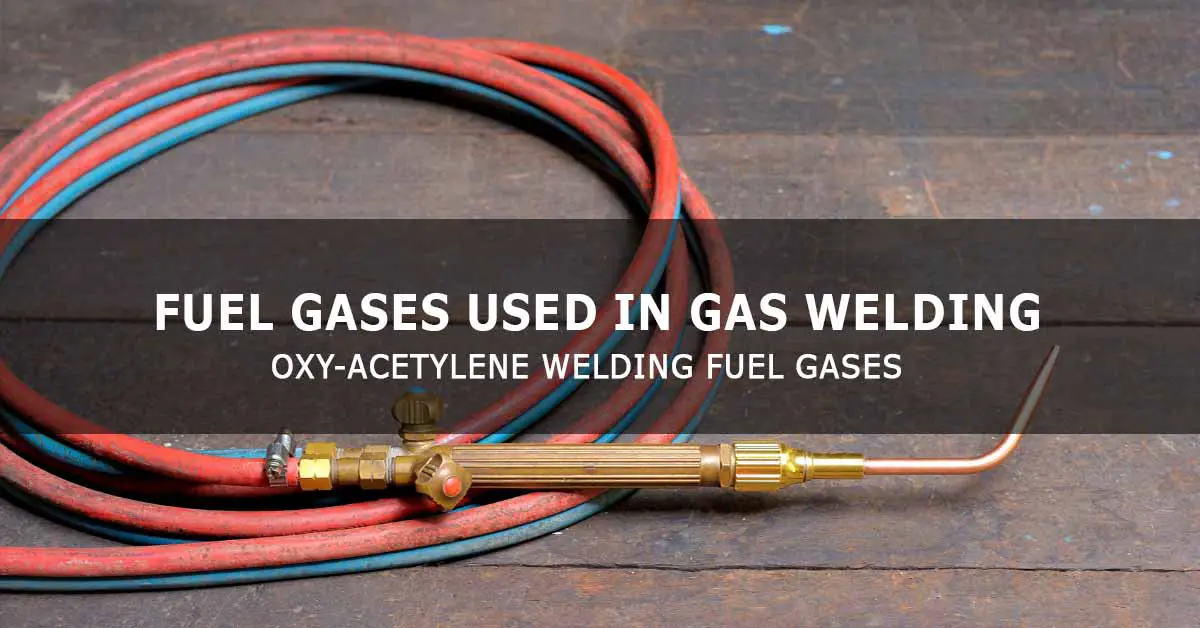Oxy-fuel welding and cutting use a variety of fuel gases; acetylene is the prevalent fuel gas used in gas welding due to its favorable flame characteristics and high temperature.
Other fuel gases used are gasoline, hydrogen, propane, natural gas, liquefied petroleum gas (LPG), MAPP gas.
These fuel gases do not provide sufficient heat required for welding; however, they can be used for soldering and brazing.
Types of Gas Welding Gases
1. Acetylene
Acetylene is the most popular fuel gas used for gas welding and gas cutting. Due to the popularity of acetylene, people often use the phrase ‘oxyacetylene welding’ or ‘oxyacetylene cutting’ instead of gas welding or gas cutting.
Acetylene, when burns and combined with oxygen, generated a temperature of 3200 °C to 3500 °C (5800 °F to 6300 °F).
The main disadvantage of acetylene in comparison to other fuels is the high cost. Besides, acetylene is not suitable for underwater welding or cutting as it is unstable when the pressure goes beyond 33 feet/10 meters underwater. Hydrogen is the preferred gas for underwater welding or cutting.
As the acetylene is unstable above 2.07 bar (30 PSI) pressure and may explode, acetylene is stored in special cylinders designed to keep the gas dissolved.
Porous materials such as kapok fiber are typically packed in the acetylene cylinder, then the cylinder is 50% filled with acetone, as acetylene is soluble in acetone.
2. Gasoline
Oxy-gasoline or oxy-petrol torches perform pretty well. It is useful specifically at places where bottled fuel gas is not available.
The cutting efficiency of the oxy-gasoline flame is equivalent or sometimes better than the oxyacetylene flame. Besides, gasoline is cheaper than propane or acetylene.
Oxy-gasoline gas with a suitable torch can cut steel plate up to 0.5 in (13 mm) thick at the same rate as oxyacetylene, and with a better rate for plate thicknesses greater than 0.5 in. with 4.5 in (110 mm) and more thick steel plate, the rate is three times better than oxyacetylene.
3. Hydrogen fuel gas
Oxy-hydrogen flame is suitable for welding and cutting aluminum. The hydrogen produces a clean flame, as well as a good flame when heating large amounts of material.
You can get a temperature of 2000ºC for hydrogen mixed with air at atmospheric pressure and 2800ºC when hydrogen is mixed with pure oxygen in the ratio of 2:1.
Hydrogen is more stable at a higher pressure compared to acetylene. Therefore, hydrogen is preferred for underwater welding and cutting.
Due to hydrogen embrittlement, hydrogen is not used for welding steel and ferrous metals. Hydrogen can be used for underwater welding and cutting.
4. Propane or LPG (Liquefied Petroleum Gas) fuel gas
Oxy-propane is generally used for metal cutting as it does not produce a high temperature like oxyacetylene, and hence it usually is not used for welding. However, oxy-propane cuts faster than oxyacetylene, cut edges are much cleaner and more useful for heating and bending than acetylene.
Oxy-propane is preferred for the heating and bending process. Propane is cheaper than acetylene and is readily available; hence, oxy-propane is used for cutting scrap. The maximum propane flame temperature is 2,822 °C (5,112 °F) mixed with oxygen.
A standard oxyacetylene torch can be used for oxy-propane; however, it is not recommended. A special oxy propane torch is usually used, which is much easier to light and less likely to blow out than oxyacetylene torches.
5. Butane and butane/propane mixes fuel gases
Similar to propane, butane is a saturated hydrocarbon. Butane and propane do not react with each other; therefore, both are regularly mixed.
Due to the different boiling temperatures of butane and propane, both are mixed to attain the required vapor pressure by the end-user.
The mixture is made depending on the ambient conditions. When the ambient temperature is very low, a higher propane percentage is required to achieve higher vapor pressure at the given temperature.
6. MPS and MAPP fuel gases
Methylacetylene-propadiene gas and MAPP gas Methylacetylene-propadiene (MAPP) are similar to LPG gas in storage and shipping characteristics; however, their heat value is slightly lower than that of acetylene.
MPS and MAPP are generally not preferred in welding applications; however, both fuel gases are recommended for cutting applications. MPS and MAPP cutting torches can cut up to 12-inch thick (300 mm) steel.
MPS and MAPP can be shipped and stored in small containers as these gasses increased compressibility allows for more gas storage in a cylinder. Therefore, it is commonly used among hobbyists as well as large industrial companies and shipyards where handling large gas cylinders is an issue.
Besides, MPS and MAPP do not polymerize at high pressures and can be used at much higher pressures than acetylene. Hence, they are much less dangerous than acetylene and do not need special safe handling or storage procedures.
Read more: A Detailed Guide To Oxy-Fuel (Oxyacetylene) Welding
References:





